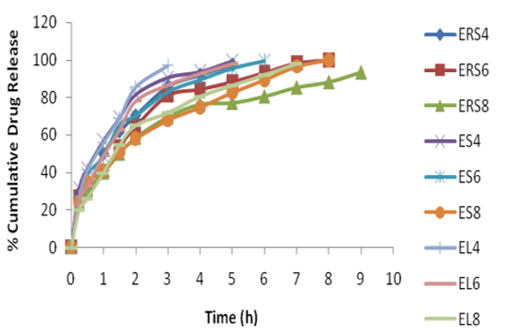Abstract
This work aims at investigating the effects of different hydrophobic polymers alone and in combination with hy- drophilic polymers on in vitro drug release in an attempt to formulate matrix tablets of desvenlafaxine succinate. Matrix tablets were prepared by wet granulation method employing different types and levels of polymers viz. Eudragit RS-100, Eudragit S-100, Eudragit L-100 and hydroxypropyl methylcellulose (HPMC) K15M. The granules were evaluated for angle of repose, density, compressibility index and Hausner’s factor showed satisfactory re- sults. Compressed tablets were evaluated for thickness, friability, hardness, uniformity of weight, content of active ingredient, swelling and in vitro dissolution studies. FT-IR spectra revealed that there was no interaction between drug and polymers. All the formulations showed compliance with pharmacopoeial standards. It was observed that combination of both hydrophilic and hydrophobic polymers in equal concentration exhibited the best release pro- file compared to be used alone and able to sustain the drug release for 10 h. The studies indicated that the drug release can be modulated by varying concentrations and types of polymers. The formulations were subjected to stability studies at different temperature and humidity conditions as per ICH guidelines. Combination of polymer undergoes swelling as well as erosion during the dissolution study, which indicates that polymer relaxation had a role in drug release mechanism. The release data were fitted to various mathematical models such as Higuchi, Korsmeyer-Peppas, first-order and zero-order to evaluate the release kinetics and mechanism of the drug release found to be diffusion coupled with erosion.
Full text article
Authors

This work is licensed under a Creative Commons Attribution-NonCommercial-NoDerivatives 4.0 International License.

